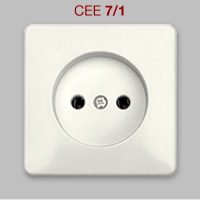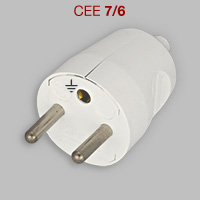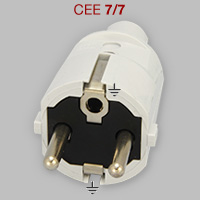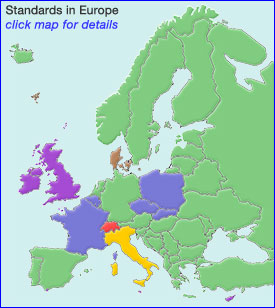 |
CEE 7 standard for domestic plugs and sockets |
| CEE is an abbreviation of Certification of
Electrotechnical Equipment.
Standards were published by the IECEE (International commission on
rules for the approval of electrical equipment). Full name of CEE publication 7 is "Specification for plugs and socket-outlets for domestic and similar uses". CEE 7, dating back to the early 1950s, unifies standards utilized in several continental European countries. Beside CEE 7 two other CEE plug/socket standards have existed; a potential source of confusion. |
 |
 |
 |
 |
 |
 |
 |
 |
 |
 |
 |
 |
 |
| CEE type |
Main
characteristics |
Related
museum pages |
|
| 7/1 |
16A
unearthed socket that accepts each of
the CEE 7 type plugs. Most socket have a shallow recess. Sockets that
accept plugs with a ca. 38 mm round base go back to the early twentieth
century. In a growing number of European countries unearthed sockets are no longer allowed in newly build houses. |
7/1-2 images and details |
|
| 7/2 | Round
base 16A unearthed plug that fits in CEE 7/1 sockets only. CEE 7/2
plugs will gradually disappear in favour of more versatile 16A CEE 7/17
or 2.5A CEE 7/16. |
||
| 7/3 | 16A earthed socket with two peripheral
earth contacts. The design, also known as Schuko, dates back to the late 1920s (see origin). |
7/3-4 images and details |
|
| 7/4 | 16A plug with earth clips, often indicated
as Schuko plug. Designed for CEE 7/3 sockets. Plugs fit also in CEE 7/1
sockets, but without earth connection. |
||
| 7/5 | 16A socket with an earth pin, known as
French type, which is in fact an incorrect name. The socket type was introduced in France in the 1950s, but already two decades earlier in Belgium (see origin). |
7/5-6 images and details |
|
| 7/6 | 16A plug that matches with socket CEE 7/5.
Fits also in CEE 7/1 socket, but without earth connection. |
||
| 7/7 | CEE 7/4 do not fit in CEE 7/5, and CEE 7/6
do not fit in CEE 7/3 sockets. Plug type 7/7 has been designed to solve
this incompatibility problem. Cords fixed to irons, vacuum cleaners
etc.have nearly always fixed CEE 7/7 plugs, but rewirable plugs are
also available. |
7/7 images and details | |
| 7/16 | 2.5A not earthed plug that is compatible
with each of the three CEE sockets and also with Danish, Italian and
Swiss standard domestic sockets. A true (continental) Europlug. Plugs
have pin with a diameter of 4.0 mm and must have insulating sleeves. |
7/16 images and details | |
| 7/17 | Unearthed plug rated at 16A and is compatible with each of the CEE 7 and Danish sockets. Most CEE 7/17 plugs are molded to appliance cords, but in a couple of countries rewirable plugs are available. CEE 7/17 have 4.8 mm pins without sleeves. | 7/17 images and details |
| CEE 7 CEE 17 - IEC 60309 CEE 22 - IEC 60320 |
There have been three CEE standards for
plugs and socket: CEE 7 (2.5 -16A, 250V for domestic use), CEE 17
(large range for
industrial use) and CEE 22 (0.2 -16A, 250V appliance connectors). CEE 7
is the only CEE standard to retain its name. CEE 17 became IEC 60309*. However in
practice the use of "CEE plug /socket" can be confusing. Several
manufacturers use CEE (without 17) for industrial plugs
and
sockets, rather than IEC 60309. CEE 22 is now IEC 60320, a generally accepted name. *IEC = International Electrotechnical Commission. |
| |
D i g i t a l M u s e u m o f | |
P l u g s a n d S o c k e t s | |
